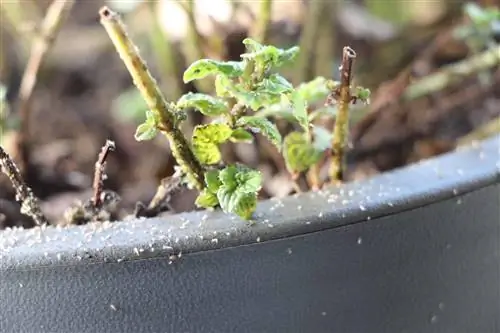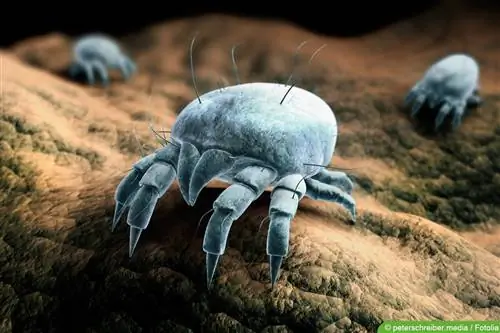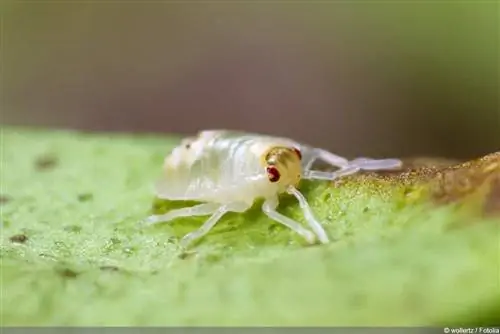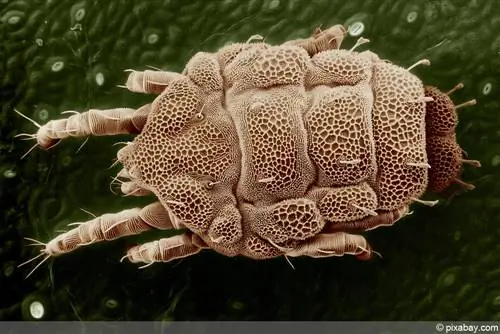- Author admin [email protected].
- Public 2023-12-17 03:39.
- Last modified 2025-06-01 06:48.
In the house, the pests like to settle on all types of houseplants, where they are particularly active in the autumn and winter months due to the dry heating air. Things don't look any better in greenhouses: Here they settle in the radiation area of the heating pipes and near doors and ventilation openings.
Why are spider mites so common?
Dry, warm air and the lack of natural enemies are an invitation for spider mites to settle and spread - and they multiply at a rapid pace:
- It takes 10-20 days for a spider mite egg to develop into an adult spider mite.
- It prefers young, soft leaves, but is not limited to these. There it quickly forms colonies under the right conditions.
- A single adult female produces approximately 50 to 100 eggs over the course of her two to five week life.
- The female spider mites overwinter in colonies in sheltered places such as fallen leaves and under the bark of woody host plants.
- They can easily survive in temperatures of -15°C for several weeks.
- If conditions improve after low temperatures and high humidity, sudden mass infestations can occur.
Signs of spider mite infestation
When infested, small, yellowish-white spots initially appear on the leaves, and in places a silvery sheen appears. The spider mite first attacks the underside of leaves, but also the shoots, where it forms delicate webs in which it resides and reproduces. More severely infected leaves change color from green to gray or copper-brown and eventually fall off.
Prevention
It is best to naturalize natural enemies such as predatory mites and predatory bugs. Also useful: ladybirds and lacewing larvae (larvae can be ordered from specialist retailers) and their promotion through species-rich greenery with a regular supply of flowers: Leave individual daisy and umbelliferous plants in the beds - these offer many beneficial insects whose larvae are parasitic or predatory. Shelter and food.
- Watering the garden thoroughly - especially on hot days.
- Spray houseplants with low-lime water in winter, also to increase the humidity.
- Use of beneficial acaricides (pesticides or biocides to combat mites and ticks, available from gardening stores).
Combating spider mites
Before any control measure that goes beyond the use of beneficial insects, you should find out thoroughly whether the plant in question can tolerate them. The earlier you detect a spider mite infestation on a plant, the greater the chance of limiting the infestation in the same year! Therefore, you should pay careful attention to signs such as silvery shine and light spots on the leaves. To determine whether it is a spider mite infestation, wipe the underside of the leaves with a white paper handkerchief: If there is an infestation, red or green dots or stripes can be seen on the handkerchief. Spraying the undersides of the leaves with water makes the animals' webs visible at an early stage.
- Isolate individual infected plants.
- Apply the treatment described to neighboring plants.
- Intensive spraying washes spider mites off the plant and can prevent mass reproduction of the animals.
Caution: Submerging potted plants is of no use - the animals then surround themselves with protective air sacs!
- For potted plants, wipe and rinse leaves.
- Then water and place a transparent plastic bag over the plant for a few days
- and attach the bottom edge to the pot with an elastic band.
It is recommended to repeat this procedure more often and to combine it with the use of predatory mites. Once the predatory mites have exterminated their prey, they die after a while. In the garden, the plants are rinsed thoroughly with as hard a jet of water as possible, not forgetting the undersides of the leaves. After that, the most promising method is the combination of increasing the humidity through abundant watering, together with the use of predatory mites.
Young predatory mites rely on absorbing water droplets, so spraying the plants and moistening the paths benefits them. When there is a lack of food, the adult predatory mites migrate, the young remain on the plants and completely eradicate the spider mite infestation. If the infestation is still moderate, you can proceed as follows:
- Hosting down several times with garlic water (briefly bring 500 g of garlic to 10 l of water and let it steep)
- Or spray extra strong basil tea.
- A decoction of field horsetail, which you spray on affected plants and neighboring plants after rinsing, can also help. (Repeat this treatment over a longer period of time.)
The following mixture of essential oils has also been used successfully: 15 drops of lavender, 15 drops of tea tree oil, 5 drops of thyme in 1/2 liter of water. You should especially work on the undersides of the leaves, as this is where the spiders are located.
Neem tree products (available in organic garden shops) can be used both on already infected plants and as a preventive measure
They contain the active ingredient azadirachtin from the Indian neem tree, which hinders the animals' development. If they ingest this, they stop eating, no longer mate and no longer lay eggs. Treatment with neem products should under no circumstances be combined with the use of beneficial insects, as these try to feed on the spider mites and can be harmed!
Insecticides are not particularly suitable for controlling spider mites because they are arachnids
The general rule for pesticides is: hardly any group of pests develops resistance to poison more quickly than the spider mite - often after just two applications there is no longer any effectiveness, which is why several agents have to be used!
- Treatment of hard-leaved plants with certain oils (white oil, paraffin or rapeseed oil). They glue the animals' breathing openings together so that they collapse.
- Sprays that are gentle on beneficial insects and are based on natural fatty acids and potassium s alts are also helpful.
- Specialist retailers offer a range of non-toxic shoot sprays based on rapeseed or mineral oil. Sprayed during sprouting helps fight spider mites.
What you should know about spider mite control in brief
Since spider mites become resistant to poisons much more quickly than their natural counterparts due to their rapid life and reproduction cycle, the use of toxic sprays quickly gives them the advantage of being able to spread unhindered, while their predators are rigorously eradicated.
- The common spider mite spreads quickly, especially in hot, dry summers, but also in the dry air of heated rooms and in greenhouses.
- The tiny, yellowish or reddish spider sits mainly on the underside of the leaves. Starting with the older leaves right up to the tips of the shoots, it gradually covers the entire plant with its fine silvery web and sucks the juice from the leaves. The affected buds and shoots are severely restricted in their development, the leaves wither and die.
- A spider mite infestation is always a sign of drought. Water treatments in any form are therefore the most important immediate measure. You can conveniently put potted plants in the shower.
Procedures for potted and garden plants
- Potted plants can be sprayed with water, placed in a plastic bag and tied up. The plants survive this procedure for a few days, the spiders do not. Similarly, you can keep garden plants moist by frequently misting or hosing them down.
- Stinging nettle manure has also proven effective on fruit trees. To do this, add 1 kg of fresh nettles to 10 l of water and let it ferment for a few days (stir daily!). This broth is diluted 1:50 and sprayed onto the affected parts of the plant.
- Predatory mites or flower bugs can be used as natural enemies in the greenhouse. They prefer to eat spider mites and other pests and otherwise do no damage to the plants.
- Even if there are many remedies and options: in the case of very severe infestations, only chemical sprays or, to at least avoid spreading, severe cutting back or the destruction of the affected plant can help.
If you manage to offer your plants the best possible conditions in the long term, you will hardly have the problem of spider mites in the future.






